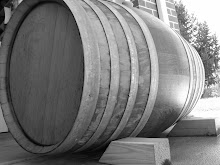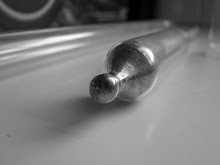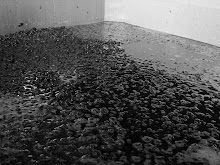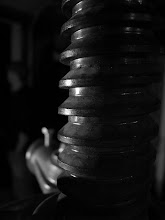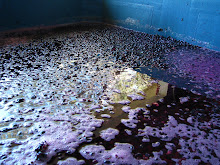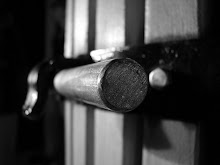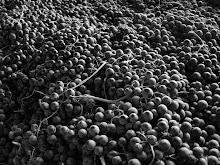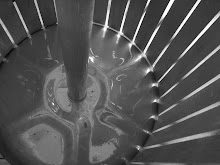Malolactic – The question of the year. Should we initiate it, should we let nature run its course, is it even necessary?
For us, yes it’s necessary. Should we let nature run its course? Tried that. We gave it forty some days to start, and are now taking matters into our own hands. Why, you ask? Because we can’t use sulfite to protect our wine until MLF is complete, and we sure as hell don’t want to lose 68.5 gallons of wine because we waited too long.
So we got 4 vials of White Labs Malolactic Bacteria (WLP675) to do the work. We boiled 1 gallon of Tree Top Apple Juice (no preservatives), 13 ounces of our wine, and ½ teaspoon of LD Carlson Yeast Energizer / Nutrient Booster. We allowed this to cool and poured in the 4 vials of bacteria. This was then capped and placed in the barrel room (69 degrees – I know, I wish it was cooler) for one week to propagate enough culture to inoculate our barrel of wine.
On Friday, December 19, 2008 at 2:00 pm we sanitized our equipment and readied the barrel for inoculation. Basically, we had to siphon 1 gallon of wine out to make room for our culture. After a little trial and error, we were able to pour the culture into our barrel, a little into our 5 gallon carboy, and just a touch into our ½ and (1) one-gallon growlers.
How long until it is done? Somewhere between four and twelve weeks, depending on the strength of the culture and its ability to get some work done. Currently we have the ferm-rite bung on, in case there is a build up of gases. We will continue to monitor the fermentation and replace the ferm-rite with a solid bung when we deem safe. Oh boy, more waiting. Winemaking is a lesson in patience. Feast and famine.
Merry Christmas from the entire 2426 West crew – Chad, Carissa, and Branden
For us, yes it’s necessary. Should we let nature run its course? Tried that. We gave it forty some days to start, and are now taking matters into our own hands. Why, you ask? Because we can’t use sulfite to protect our wine until MLF is complete, and we sure as hell don’t want to lose 68.5 gallons of wine because we waited too long.
So we got 4 vials of White Labs Malolactic Bacteria (WLP675) to do the work. We boiled 1 gallon of Tree Top Apple Juice (no preservatives), 13 ounces of our wine, and ½ teaspoon of LD Carlson Yeast Energizer / Nutrient Booster. We allowed this to cool and poured in the 4 vials of bacteria. This was then capped and placed in the barrel room (69 degrees – I know, I wish it was cooler) for one week to propagate enough culture to inoculate our barrel of wine.
On Friday, December 19, 2008 at 2:00 pm we sanitized our equipment and readied the barrel for inoculation. Basically, we had to siphon 1 gallon of wine out to make room for our culture. After a little trial and error, we were able to pour the culture into our barrel, a little into our 5 gallon carboy, and just a touch into our ½ and (1) one-gallon growlers.
How long until it is done? Somewhere between four and twelve weeks, depending on the strength of the culture and its ability to get some work done. Currently we have the ferm-rite bung on, in case there is a build up of gases. We will continue to monitor the fermentation and replace the ferm-rite with a solid bung when we deem safe. Oh boy, more waiting. Winemaking is a lesson in patience. Feast and famine.
Merry Christmas from the entire 2426 West crew – Chad, Carissa, and Branden





